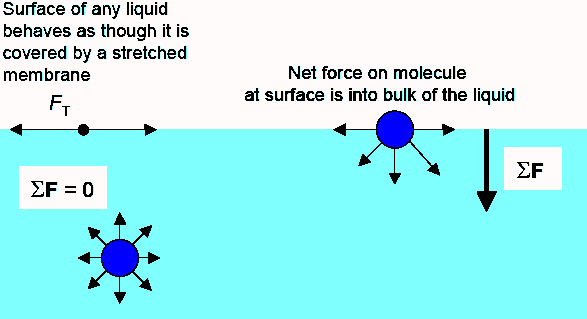This systematic introduction to the topic includes theoretical concepts to help readers understand and predict surface forces, while also integrating experimental techniques and practical applications with uptodate examples plus motivating exercises. Surface tension or surface (free) energy arises from the shortrange forces that are responsible for the liquid state of materials, i. , van der Waals forces (in particular, dispersion forces that are always present), hydrogen bonding, and metal bonding. forces to increase the total area of the surface. Mathematically, the internal surface forces are represented by surface tension, dened as the normal force per unit of length. have positive interfacial energy density. The sign depends on the strength of the cohesive Surface tension is thus identical to surface energy density, and is. A general introduction to surface and interfacial forces, perfectly combining theoretical concepts, experimental techniques and practical applications. In this completely updated edition all the chapters have been thoroughly revised and extended to cover new developments and approaches with around 15 new content. Particularly, surface and interfacial forces (van der Waals, electrical double layer, hydrophobic force, hydration, hydrodynamic, and adhe sion forces) are of great importance to understand inter. This systematic introduction to the topic includes theoretical concepts to help readers understand and predict surface forces, while also integrating experimental techniques and practical applications with uptodate examples plus motivating exercises. Interfacial tension is somewhat similar to surface tension in that cohesive forces are also involved. However the main forces involved in interfacial tension are adhesive forces (tension) between the liquid phase of one substance and either a solid, liquid or gas phase of another substance. Description This systematic introduction to the topic includes theoretical concepts to help readers understand and predict surface forces, while also integrating experimental techniques and practical applications with uptodate examples plus motivating exercises. The surface tension and interfacial tension are the result of imbalanced intermolecular forces at the surface of a liquid or at the interface between liquids. Inside a liquid, any molecule has an equal number of neighboring molecules. Interfacial and adhesion forces between living, unmodified bacterial cells (Escherichia coli) and mineral surfaces (muscovite, goethite, and graphite) have been directly measured in aqueous solution using a force microscope. Native cells are linked to a forcesensing probe that is used to characterize interactions as a mineral surface approaches, makes contact with, and withdraws from bacteria. Hence the surface tension of a liquid would consist of two components, d, due to dispersion forces and p due to polar interactions which include Keeson and Debye forces as well as hydrogen bonding. Pure hydrocarbon liquids interact with other liquids through dispersion forces only and the interfacial tension between liquids, a hydrocarbon. Interfacial Forces in Dispersion Science Interfacial forces determine many phenomena in dispersion science and technology. Eight types of interfacial tension, surface energy, interfacial. Surface tension Interfacial tension measurement demonstration using Du Nouy ring Wilhemy plate methods on The Sigma Force Tensiometer. For further inform Extra resources for Surface and Interfacial Forces From Fundamentals to Applications. The reflectivity data were footprintcorrected for the varying flux on the sample as Q increased. Home made solidliquid and solidgas tight experimental chambers. A general introduction to surface and interfacial forces, perfectly combining theoretical concepts, experimental techniques and practical applications. In this completely updated edition all the chapters have been thoroughly revised and extended to cover new developments and approaches with around 15 new content. Attension I Surface and interfacial tension [3 Surface tension depends on temperature and pressure One of the main factors affecting surface tension of pure liquids is the temperature. About Khan Academy: Khan Academy offers practice exercises, instructional videos, and a personalized learning dashboard that empower learners to study at. A general introduction to surface and interfacial forces, perfectly combining theoretical concepts, experimental techniques and practical applications. In this completely updated edition all the chapters have been thoroughly revised and extended to cover new developments and approaches with around 15 new content. (2010) Hydrodynamic Forces, in Surface and Interfacial Forces, WileyVCH Verlag GmbH Co. Find helpful customer reviews and review ratings for Surface and Interfacial Forces at Amazon. Read honest and unbiased product reviews from our users. The meeting's emphasis was given to Surface and Interfacial Forces From Fundamentals to Applications. The contributions from leading scientists cover a broad spectrum of topics concerning Surfaces and interfacial phenomena, New methods and techniques, Amphiphilic systems, Synthesis and applications of nanocolloids. The California Consortium for Urban Indian Health (CCUIH) is an alliance of direct service Urban Indian health organizations that supports health promotion and access for American Indians living in cities throughout California. The nature and the interfacial force connection depend on the structure, on the surface characteristics of the fibers (roughness, determined surface, porosity, crystal dimension, the presence of functional classifications chemical active) and on structural characteristics of the matrix (chemical composition, macromolecules conformation). Intermolecular and Surface Forces describes the role of various intermolecular and interparticle forces in determining the properties of simple systems such as gases, liquids and solids, with a special focus on more complex colloidal, polymeric and biological systems. The book provides a thorough foundation in theories and concepts of. The shape of the hanging drop of liquid is the result of the competing forces of gravity, trying to pull the drop into a pear shape, and surface tension, trying to maintain a sphere. By analysis of the resulting drop shape surface tension and interfacial tension can be calculated. Surface tension is measured as the energy required to increase the surface area of a liquid by a unit of area. The surface tension of a liquid results from an imbalance of intermolecular attractive forces, the cohesive forces between molecules: . A molecule in the bulk liquid experiences cohesive forces with other molecules in all directions. A general introduction to surface and interfacial forces, perfectly combining theoretical concepts, experimental techniques and practical applications. To rationalize these findings, we discuss how solution pH and membrane surface charge affect interfacial forces involved in vesiclesubstrate interactions. Taken together, our findings present a comprehensive picture of how interfacial forces dictate the pathway of phospholipid vesicle adsorption onto silicon dioxide surfaces and offer a. ship between interfacial electroadhesive forces and surface textures as the substrate material itself will greatly influence the obtainable electroadhesive forces. Nanostructures formed by chemical reaction can modify the interfacial forces present in aqueous solution near a surface. This study uses forcevolume microscopy to explore this phenomenon for the growth of manganese oxide nanostructures on rhodochrosite. that one parameter, the interfacial (surface) tension, accounts for all mech COLLOID TRANSPORT BY INTERFACIAL FORCES 65 thermal energy. Motion of a particle is induced by an applied field Yoo(x), which is usually electrical potential, temperature, or the concentration of a. The meetings emphasis was given to Surface and Interfacial Forces From Fundamentals to Applications but also provided a general overview on current aspects of colloid and polymer science in fundamental research and applications. Interfacial Phenomena and Surface Forces of Hydrophobic Solids Dean J Mastropietro ABSTRACT At the molecular level the entropic hydrophobic effect is responsible. Surface and interfacial forces. [HansJrgen Butt; Michael Kappl This systematic introduction to the topic includes theoretical concepts to help readers understand and predict surface forces, while also integrating experimental techniques and practical. So, surface tension is due to cohesion between the water molecules at the surface of a liquid, but water molecules aren't just attracted to each other. They're actually attracted to the container too and other materials, and that's called adhesion. The meetings emphasis was given to Surface and Interfacial Forces From Fundamentals to Applications but also provided a general overview on current aspects of colloid and polymer science in fundamental research and applications. Adhesion is the tendency of dissimilar particles or surfaces to cling to one another (cohesion refers to the tendency of similar or identical particlessurfaces to cling to one another). The forces that cause adhesion and cohesion can be divided into several types. The intermolecular forces responsible for the function of various kinds of stickers and sticky tape fall into the categories of. Surface and Interfacial Forces by Michael Kappl, , available at Book Depository with free delivery worldwide. Surface tension is an effect where the surface of a liquid is strong. The surface can hold up a weight, and the surface of a water droplet holds the droplet together, in a ball shape. Some small things can float on a surface because of surface tension, even though they normally could not float. 1 Intermolecular and Surface Forces ChemE 554ove 3 Covalent Bond: The standard example for a covalent bond is the hydrogen atom. When the wavefunction overlap is considerable, the electrons of the hydrogen atoms will be Thoroughly revised and reorganized, the second edition of Interfacial Forces in Aqueous Media examines the role of polar interfacial and noncovalent interactions among biological and nonbiological macromolecules as well as biopolymers, particles, surfaces, cells, and both polar and apolar polymers. Journal of Environmental Sciences 21(2009) 304 Interfacial forces between silica surfaces measured by atomic force microscopy DUAN Jinming Key Laboratory of Northwest Water Resource, Environment and Ecology, MOE, Xi'an University of Architecture and Technology, Xi'an, China. Surface tension is defined to a single liquid surface, whereas the interfacial tension is defined to the interface of two immiscible liquids. Surface tension is actually a derivation of interfacial tension where force from the second surface is negligible or zero. Interfacial Tension, Capillarity and Surface Forces Sofia University Peter A. Kralchevsky Department of Chemical Engineering, Faculty of Chemistry Sofia University, Sofia, Bulgaria surfaces), at which an eective interfacial (or surface) tension acts. Surface tension has the units of forcelength or equivalently energyarea, and so may be thought of as a negative surface pressure, or, equivalently, as a line tension acting in all directions parallel to the For liquidliquid systems the term used to describe these interfacial forces is interfacial tension. For liquidvapor or liquidair systems the term commonly used is surface tension. W and the two forces F1 and F2 due to the surface tension of the water. The forces F1 and F2 result from the surface tension acting along the length of the needle on either side. INTERFACIAL FORCES IN CHEMICALMECHANICAL POLISHING (CMP) A Dissertation by DEDY NG Submitted to the Office of Graduate Studies of Texas AM University.











